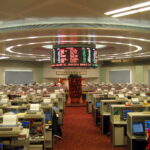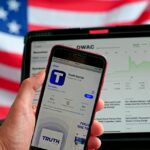The phrase “Sell America”, which was once a trading meme, has now become a financial reality. From US Treasuries, the US Dollar and the largest US stocks.
After a chaotic bond sale and a three day market crash, Donald Trump has backed down from his aggressive tariff plan. At least partially.
But the damage has been done. US futures remained flat even after the White House offered to pause tariffs for 90 days for most countries. Global stocks continued to surge.
The bond market remains roiled. Investors are openly asking whether US assets remain the safe haven that they once were.
What happened to the US markets?
Investors saw a synchronized selloff from Friday to Wednesday. This is not something that happens in developed economies.
The S&P 500, Treasuries and the dollar all fell sharply. The yield on the 10-year U.S. Treasury increased by 60 basis points over three sessions. This was the biggest move since 2001. Nasdaq entered correction territory, before rebounding by 12% within a single trading day after the tariff pause announcement.
Bonds usually rise when stocks fall. This time, it didn’t. Instead, hedge fund forced sales linked to a failed strategy of basis trading led them to dump Treasuries.
The impact was exacerbated by thin liquidity and leveraged positions. At one point the 10-year yield reached 4.515%. This was up from 3.9% only days earlier.
The U.S. Dollar also fell against safe havens such as the yen, and Swiss Franc, despite rising yields. The Dollar Index (DXY), which measures the dollar’s performance, remains lower for the month. The dollar’s failure to attract capital during a time of global stress was an important red flag.
Why did Trump reverse his course?
Trump’s tariff reversal had nothing to do with diplomacy or economy. It was all about markets.
Bloomberg and White House Insiders claim that Trump spent the first part of the week looking at bond yields and equity charts. He also listened to Fox Business commentary.
Trump blinked when the 10-year yield soared past 4.5%, and prominent allies such as Jamie Dimon and Bill Ackman warned about a recession.
His team created a post in just a few hours for Truth Social that rolled back tariffs on most countries except China. It was posted without legal review.
The move triggered Nasdaq’s biggest one-day increase since 2001. The bond market barely responded. This tells us that there is something more serious. Maybe the markets don’t think this is over.
Is the US safe-haven myth over?
This week, the phrase “Sell America”, became a viral headline for a good reason. Investors did not just sell US stocks.
They sold dollars. They sold dollars.
They sold everything. It wasn’t just day-traders or speculative fund. Pension funds, foreign central bankers, and institutional investors were rebalancing their portfolios away from US exposure.
Technical issues are a part of the problem. Basis trades went haywire. Hedge funds got margin calls. Dealers did not have the balance sheet capacity to absorb these flows.
But some of it is structural. The US has high deficits and inflation, as well as an unpredictable trade policy. This is not a safe place. This is a risky asset with reserve currency priviledges.
Foreign investors seem to be in agreement. China is said to hold around $800 billion of US Treasuries.
The foreign bids at the Treasury 3-year auction this week were among the lowest in recent years, despite the absence of hard evidence of active dumped.
Morningstar reports that domestic buyers only absorb 6.2% of the total supply, as opposed to an average of 19.%.
Meanwhile, German bunds held steady. The euro rose against the dollar. Gold climbed above $3100 per ounce as investors sought safety elsewhere.
Should we panic?
It’s not a crisis yet. It is a paradigm shift. The Fed’s room for maneuver is limited. Minutes of the Fed’s March meeting show concern that tariffs will raise inflation.
The markets are now pricing in less rate cuts for the coming year. They have dropped from over 100 basis point to around 80.
If tariffs continue to raise inflation and yields remain high, the Fed could be forced to do nothing as the economy slows.
Trump has stated that the tariff freeze is just a temporary measure. The blanket duty of 10% on all imports will remain.
The China tariff has now been raised to 125%. A new set of trade tensions may spark another selloff. The market has shown what happens when its confidence is lost.
There is also the threat of global retaliation. China has imposed 84% tariffs on US goods, and sanctions against 18 American companies.
Europe is under pressure. The long game is a test for economic endurance, especially in relation to China.
Trump is playing chicken. But China seems willing to take the pain. According to game theory, the side that is most willing to suffer will usually win.
There’s a third big risk, which is not just tariffs. Global investors losing faith in US economic governance. The policy reversals that are chaotic. Social media messaging.
The disconnection between what is said in Washington and the actual market situation.
The market is now dictating the limits of US policies. Washington pays attention when the bond market becomes “yippy”. But that is not a positive thing. It means that confidence is not automatic. The benefit of doubt is gone.
Investors are now pricing US assets as a choice among others, not as a default destination. This is the core of “Sell America”. Even if the idea pauses, it is still in play.
This post ‘Sell America: the market revolt which forced Trump to his hand’ may be modified as new developments unfold.
This site is for entertainment only. Click here to read more





